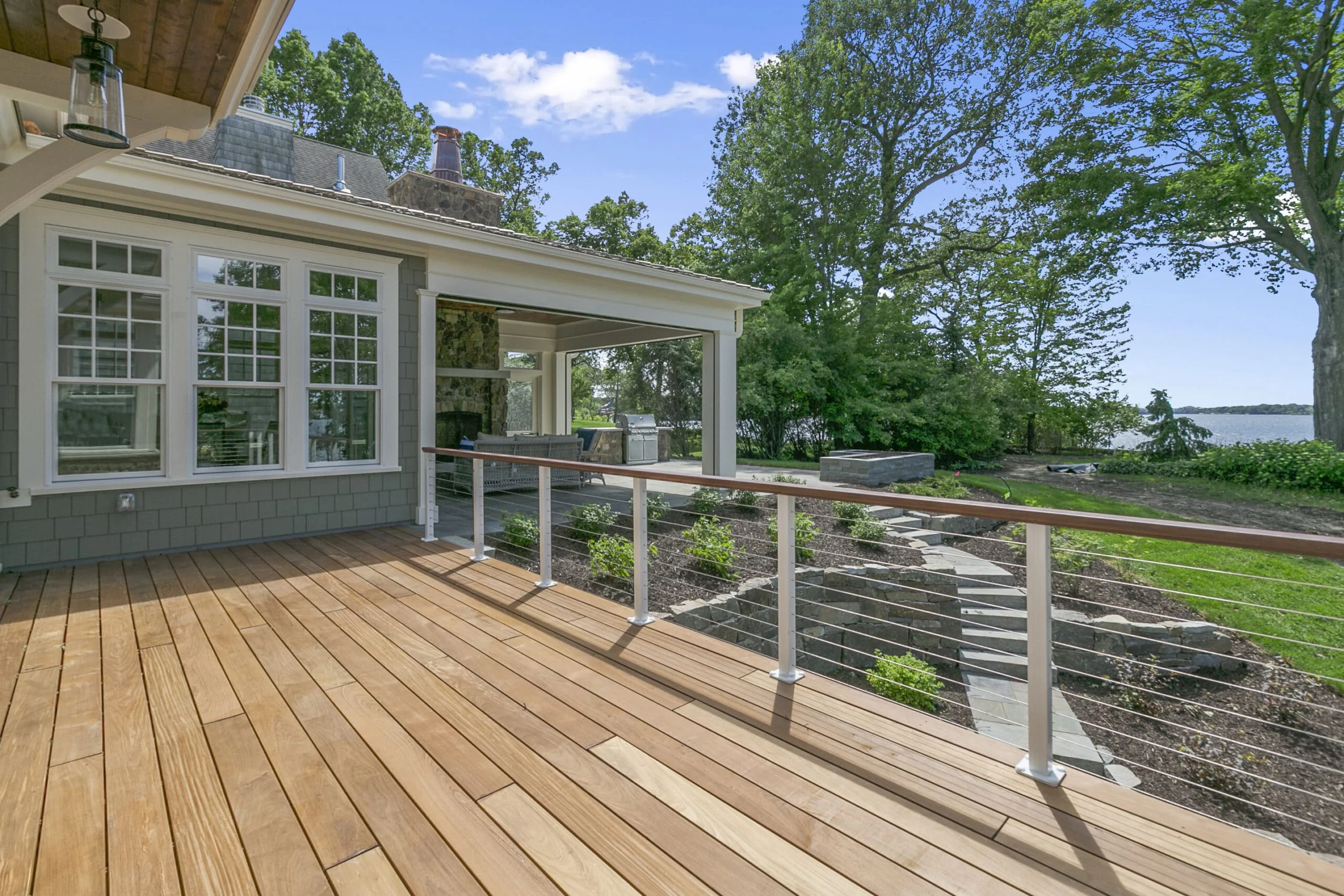
Regularly inspecting your deck is crucial for ensuring its safety and longevity. One common issue that can arise is board gaps, which can lead to bigger problems if left unchecked. These gaps can occur due to weather changes, age, and wear, potentially causing tripping hazards or even structural damage.
By having a professional deck builder perform regular inspections, you can identify and address these gaps early on, preventing costly repairs and maintaining the deck’s appearance and functionality. A professional not only spots issues that might go unnoticed but also provides expert solutions tailored to your deck’s specific needs.
Regular inspections are a smart investment, giving you peace of mind and ensuring that your deck remains a safe and enjoyable space for you and your family.
What causes gaps in deck boards to widen over time?
Gaps in deck boards can widen over time due to several factors:
- Wood Expansion and Contraction: Wood naturally expands and contracts with changes in temperature and humidity. Wood can shrink during hot, dry periods, causing gaps to widen. Conversely, in moist conditions, wood absorbs water and expands, which can also affect the fit of the boards and potentially create or exacerbate gaps.
- Improper Installation: If deck boards are not installed with the appropriate spacing or if they are not properly secured, gaps can widen over time. Inadequate spacing between boards can lead to uneven expansion and contraction, resulting in noticeable gaps.
- Deck Movement: Decks are subjected to movement from settling, shifting, or natural wear and tear. If the underlying structure or supports shift, the deck boards can shift out of alignment, leading to wider gaps.
- Moisture Damage: Excessive moisture exposure from rain or snow can cause wood to swell. When the deck dries out, the wood can shrink, creating larger gaps. Long-term exposure to moisture can also lead to warping and deterioration of the wood, worsening the problem.
- Wood Aging and Wear: Wood can become more brittle and prone to cracking or splitting as it ages. This natural aging process can widen existing gaps and form new ones.
- Poor Maintenance: Lack of regular maintenance, such as sealing or treating the wood, can lead to deterioration and increased gap formation. Proper maintenance helps protect the wood from environmental damage and reduces the impact of expansion and contraction.
Regular inspections and maintenance by a professional can help identify these issues early and address them before they lead to significant problems with your deck.
How can regular inspections by a professional deck builder prevent safety hazards?
Regular inspections by a professional deck builder are crucial for preventing safety hazards and ensuring the structural integrity of your deck. Here’s how these inspections help:
- Identify Structural Issues: A professional deck builder can detect early signs of structural problems, such as weakened support beams, damaged joists, or unstable posts. Addressing these issues before they become severe helps prevent accidents and ensures the deck remains safe.
- Check for Proper Installation: Inspectors verify that deck boards, fasteners, and other components are installed correctly. Improper installation can lead to instability and potential safety risks. Correcting installation errors helps maintain a sturdy and secure deck.
- Assess Wear and Tear: Over time, decks can suffer from wear and tear, including wood rot, rusted hardware, and deteriorated sealant. Regular inspections identify these issues, allowing timely repairs or replacements to prevent further damage and maintain the deck’s safety.
- Evaluate Deck Surface Conditions: Professionals examine the deck surface for hazards like loose boards, splinters, or protruding nails. These issues can cause tripping or injury. By addressing them promptly, the deck remains safe and user-friendly.
- Ensure Proper Drainage: Effective drainage prevents water damage and wood rot. Inspections ensure the deck is properly sloped and drainage systems are functioning correctly, reducing the risk of water-related problems.
- Verify Compliance with Safety Standards: Deck builders check that the deck adheres to local building codes and safety standards. Compliance with these regulations ensures that the deck is constructed to withstand environmental stresses and usage demands.
- Recommend Maintenance: Professional builders guide routine maintenance, such as sealing and cleaning, to extend the deck’s lifespan and prevent future safety issues. Regular upkeep based on their recommendations helps avoid potential hazards.
By conducting thorough and regular inspections, professional deck builders can identify and address potential safety hazards early, ensuring that your deck remains safe, functional, and enjoyable for years.
What are the common issues found during deck board inspections?
Common issues found during deck board inspections include:
- Cracking and Splitting: Wood deck boards can develop cracks or splits due to exposure to moisture, temperature fluctuations, or natural aging. These cracks can lead to splinters and potentially weaken the boards.
- Warping and Buckling: Moisture levels and temperature changes can cause wood boards to warp or buckle. This can create uneven surfaces and gaps, leading to potential tripping hazards and compromising the deck’s structural integrity.
- Loose or Missing Fasteners: Deck boards are secured with nails, screws, or other fasteners that can become loose or rust over time. Loose fasteners can cause boards to move or shift, posing safety risks.
- Rot and Decay: Prolonged exposure to moisture can lead to wood rot and decay, especially if the deck is not properly sealed or maintained. Rotten wood compromises the deck’s strength and safety.
- Mold and Mildew Growth: Damp conditions can lead to mold and mildew growth on deck boards. Mold can cause discoloration and contribute to wood deterioration, and it can also pose health risks.
- Insect Infestation: Pests such as termites or carpenter ants can damage deck boards by feeding on the wood, compromising the structural integrity of the deck.
- Loose or Warped Joists: Underneath the deck, joists provide structural support. Loose or warped joists can lead to instability and unevenness in the deck surface.
- Improper Spacing: Deck boards should be installed with appropriate spacing for expansion and contraction. More spacing can lead to gaps, water pooling, and potential damage.
- Nail Pops or Protruding Nails: Nails or screws that have popped up or protruded from the surface can create tripping hazards and damage the deck surface.
- Discoloration: Deck boards that are discolored can indicate water damage, mildew, or other issues. While this might not always affect safety, it can indicate underlying problems that need addressing.
Regular inspections by a professional deck builder can help identify these issues early and ensure timely repairs or maintenance to keep the deck safe and functional.
How often should a professional inspect a deck to ensure its longevity?
A professional inspection is typically recommended at least once a year to ensure a deck’s longevity and maintain its safety and functionality. However, the frequency can vary based on several factors:
- Climate and Weather Conditions: In regions with extreme weather conditions, such as heavy rain, snow, or intense heat, more frequent inspections may be necessary. For instance, areas with high humidity might require inspections every 6-9 months to address issues like mold or wood rot.
- Deck Usage: If the deck is used heavily or hosts large gatherings frequently, it might experience more wear and tear. In such cases, semi-annual inspections can help catch any issues early.
- Age of the Deck: Older decks, especially those over ten, might need more frequent inspections. The materials can degrade over time, and early detection of potential problems is crucial.
- Recent Repairs or Modifications: After significant repairs or modifications, a follow-up inspection within a few months can ensure that the work has been done correctly and that no new issues have arisen.
- Visible Concerns: If you notice any visible damage or wear, like loose boards, cracking, or unusual odors, it’s advisable to schedule an inspection sooner rather than waiting for the annual check-up.
Regular inspections help to identify and address potential problems before they escalate, ensuring the deck remains safe, attractive, and durable for years to come.
Ensure Deck Safety: Schedule Your Inspection!
Ensure Deck Safety: Schedule Your Inspection! At Bull Mountain Outdoor Living , we specialize in thorough deck inspections to keep your outdoor space safe and beautiful.
Regular inspections by our experienced professionals can identify issues like board gaps, rot, or structural weaknesses before they become major problems. Protect your investment and extend the life of your deck with our expert assessment and maintenance services.
Don’t wait until small problems become big—contact us today to schedule your comprehensive deck inspection and ensure your deck remains in top condition!








